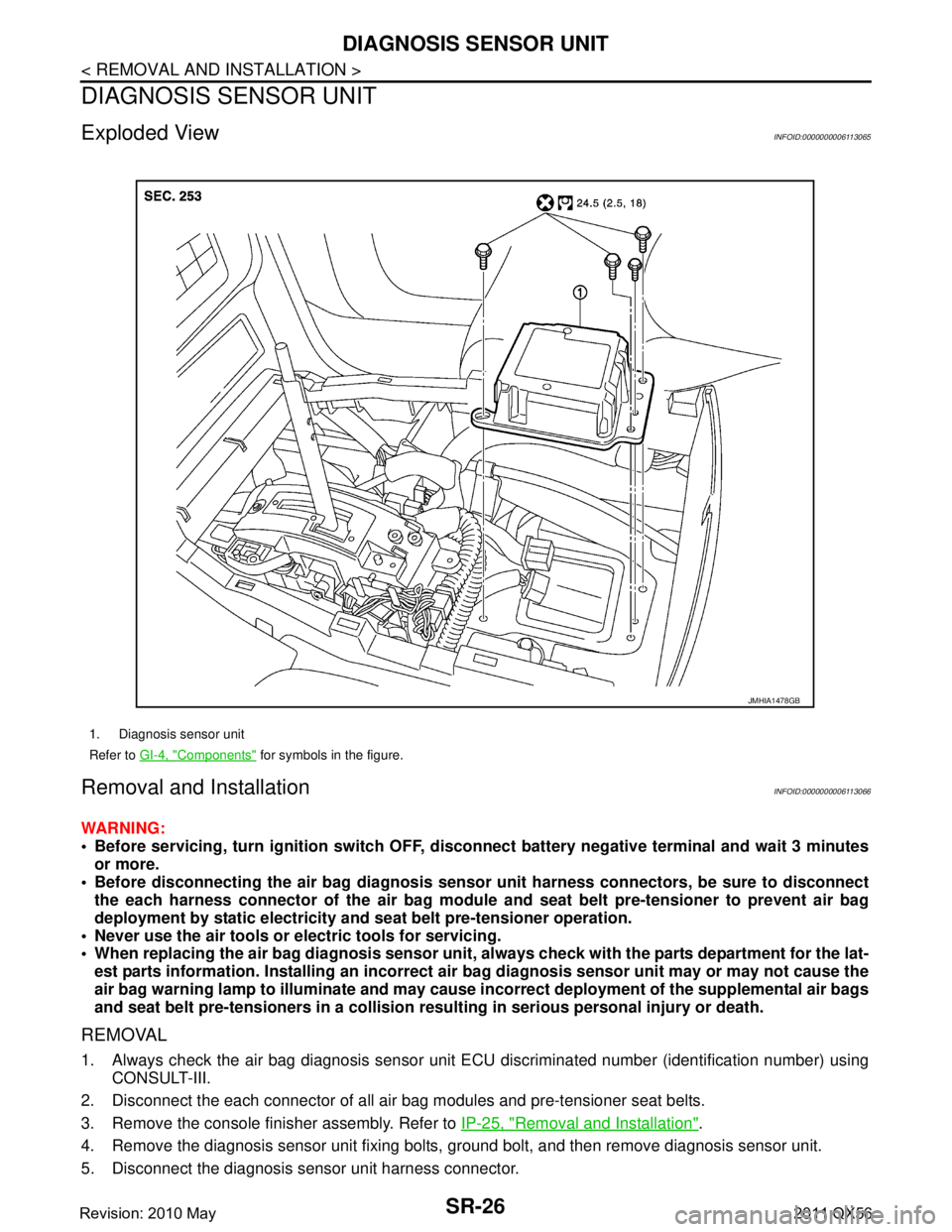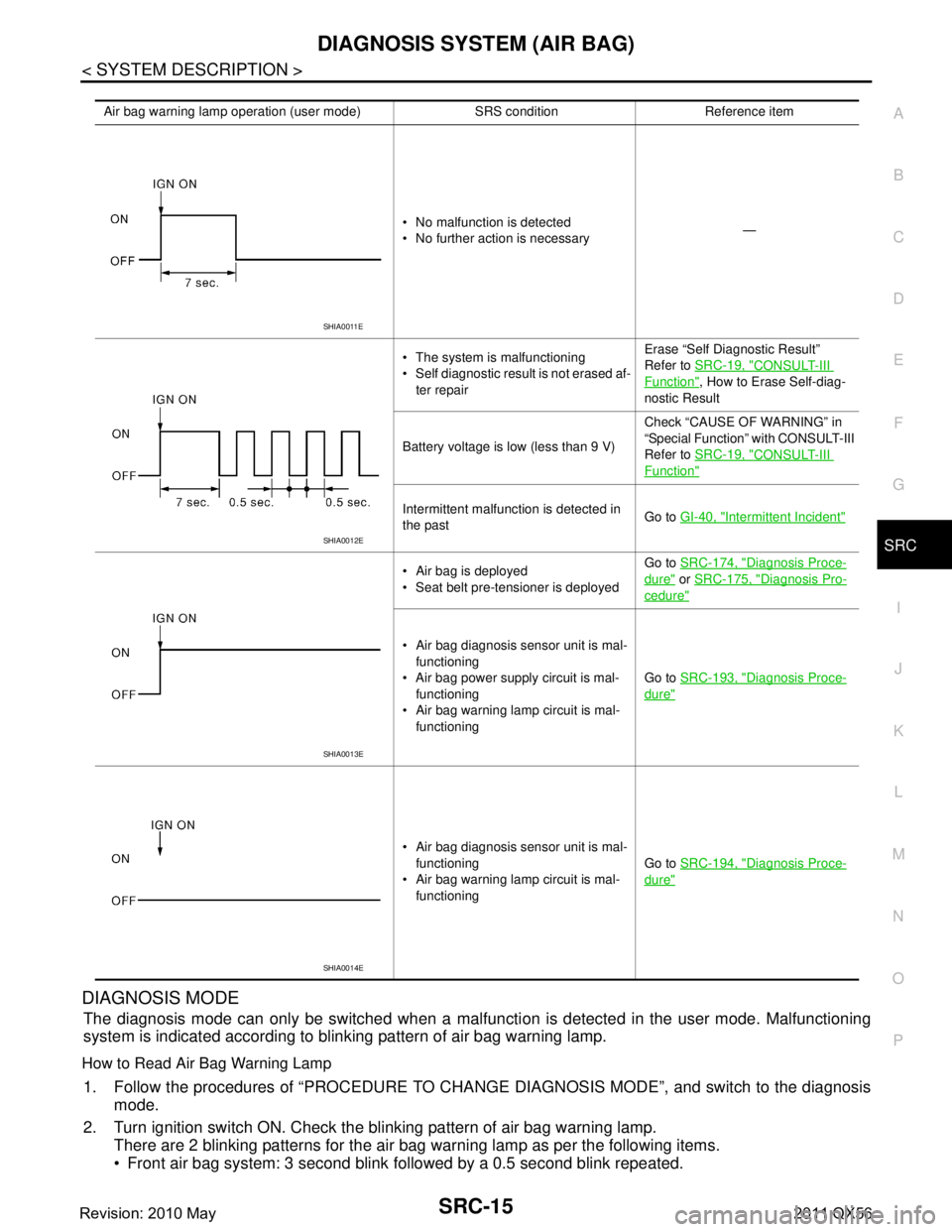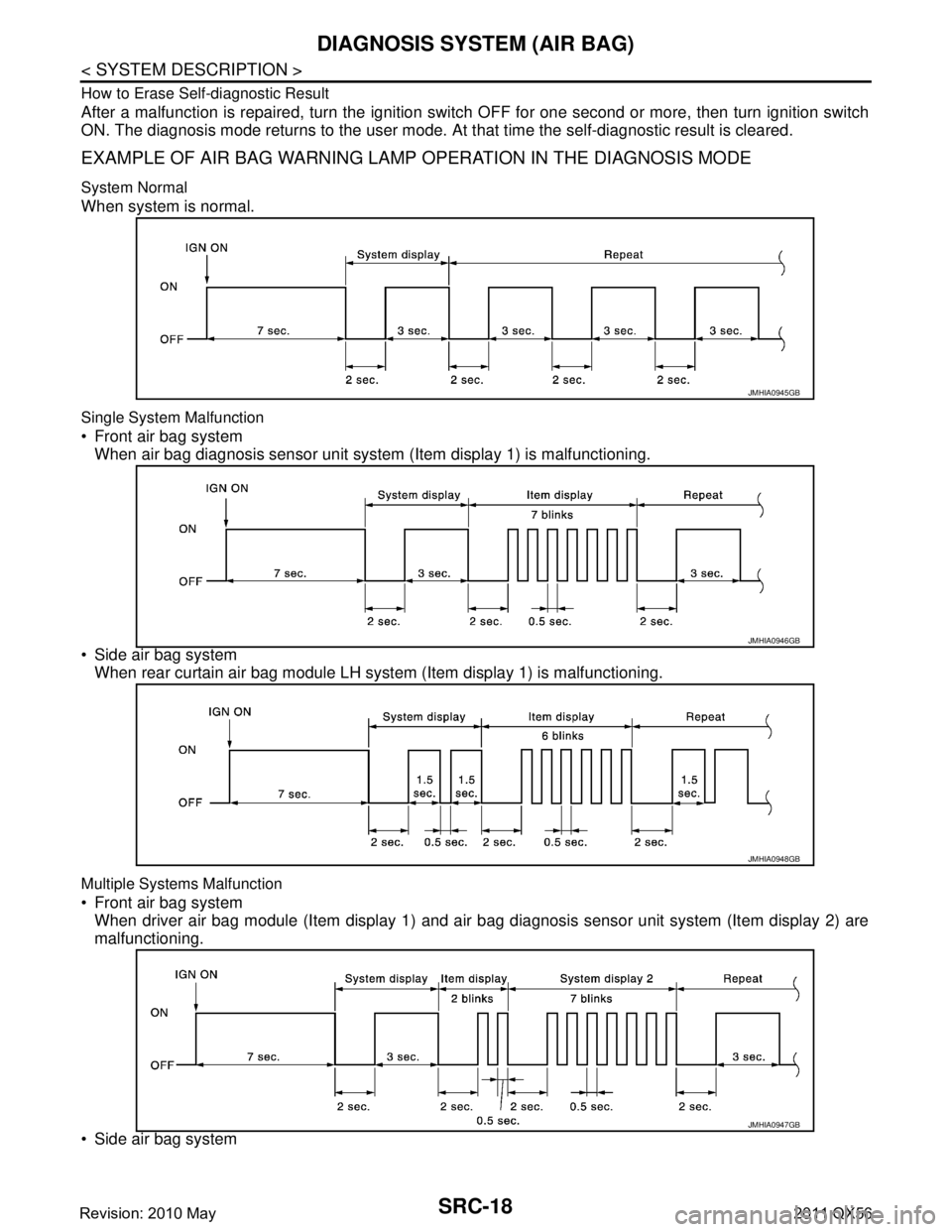2011 INFINITI QX56 ignition
[x] Cancel search: ignitionPage 4789 of 5598

SR-26
< REMOVAL AND INSTALLATION >
DIAGNOSIS SENSOR UNIT
DIAGNOSIS SENSOR UNIT
Exploded ViewINFOID:0000000006113065
Removal and InstallationINFOID:0000000006113066
WARNING:
Before servicing, turn ignition switch OFF, disconnect battery ne gative terminal and wait 3 minutes
or more.
Before disconnecting the air bag diagnosis sensor unit harness conn ectors, be sure to disconnect
the each harness connector of the air bag module and seat belt pre-tensioner to prevent air bag
deployment by static electricity and seat belt pre-tensioner operation.
Never use the air tools or electric tools for servicing.
When replacing the air bag diagno sis sensor unit, always check with th e parts department for the lat-
est parts information. Installing an incorrect air bag diagnosis sen sor unit may or may not cause the
air bag warning lamp to illuminate and may cause in correct deployment of the supplemental air bags
and seat belt pre-tensioners in a collision r esulting in serious personal injury or death.
REMOVAL
1. Always check the air bag diagnosis sensor unit E CU discriminated number (identification number) using
CONSULT-III.
2. Disconnect the each connector of all air bag modules and pre-tensioner seat belts.
3. Remove the console finisher assembly. Refer to IP-25, "
Removal and Installation".
4. Remove the diagnosis sensor unit fixing bolts, ground bolt, and then remove diagnosis sensor unit.
5. Disconnect the diagnosis sensor unit harness connector.
1. Diagnosis sensor unit
Refer to GI-4, "
Components" for symbols in the figure.
JMHIA1478GB
Revision: 2010 May2011 QX56
Page 4799 of 5598

SRC-6
< PRECAUTION >
PRECAUTIONS
PRECAUTION
PRECAUTIONS
Precaution for Supplemental Restraint System (SRS) "AIR BAG" and "SEAT BELT
PRE-TENSIONER"
INFOID:0000000006219946
The Supplemental Restraint System such as “A IR BAG” and “SEAT BELT PRE-TENSIONER”, used along
with a front seat belt, helps to reduce the risk or severi ty of injury to the driver and front passenger for certain
types of collision. This system includes seat belt switch inputs and dual stage front air bag modules. The SRS
system uses the seat belt switches to determine the front air bag deployment, and may only deploy one front
air bag, depending on the severity of a collision and w hether the front occupants are belted or unbelted.
Information necessary to service the system safely is included in the “SRS AIR BAG” and “SEAT BELT” of this
Service Manual.
WARNING:
• To avoid rendering the SRS inopera tive, which could increase the risk of personal injury or death in
the event of a collision that would result in air bag inflation, all maintenance must be performed by
an authorized NISS AN/INFINITI dealer.
Improper maintenance, including in correct removal and installation of the SRS, can lead to personal
injury caused by unintent ional activation of the system. For re moval of Spiral Cable and Air Bag
Module, see the “SRS AIR BAG”.
Do not use electrical test equipmen t on any circuit related to the SRS unless instructed to in this
Service Manual. SRS wiring harnesses can be identi fied by yellow and/or orange harnesses or har-
ness connectors.
PRECAUTIONS WHEN USING POWER TOOLS (AIR OR ELECTRIC) AND HAMMERS
WARNING:
When working near the Air Bag Diagnosis Sensor Unit or other Air Bag System sensors with the ignition ON or engine running, DO NOT use air or electric power tools or strike near the sensor(s)
with a hammer. Heavy vibration could activate the sensor(s) and deploy the air bag(s), possibly
causing serious injury.
When using air or electric power tools or hammers , always switch the ignition OFF, disconnect the
battery, and wait at least 3 minu tes before performing any service.
ServiceINFOID:0000000006219947
Never use electrical test equipment to check SRS circuits unless instructed to in this Service Manual.
Before servicing the SRS, turn ignition switch OF F, disconnect battery negative terminal and wait 3 minutes
or more.
For approximately 3 minutes after the cables are removed, it is still possible for the air bag and seat belt pre-
tensioner to deploy. Therefore, never work on any SR S connectors or wires until at least 3 minutes have
passed.
Diagnosis sensor unit must always be installed with their arrow marks “ ⇐” pointing towards the front of the
vehicle for proper operation. Also chec k diagnosis sensor unit for cracks, deformities or rust before installa-
tion and replace as required.
The spiral cable must be aligned with the neutral position since its rotations are limited. Never turn steering
wheel and column after removal of steering gear.
Handle air bag module carefully. Always place driver and front passenger air bag modules with the pad side facing upward and seat mounted front side air bag module standing with the stud bolt side facing down.
Conduct self-diagnosis to check entire SRS for proper function after replacing any components.
After air bag inflates, the front instrument panel assembly should be replaced if damaged.
Always replace instrument panel pad following front passenger air bag deployment.
Never solder the harness when making repairs. Check that harness is not pinched and that there is no con-
tact with other components.
Never allow harness to come in contact with oil, grease, waste oil, or water.
Never insert foreign materials, such as a screwdriver , into the harness connector. (This is to prevent acci-
dental activation caused by static electricity.)
Always use CONSULT-III or SRS air bag warning lamp to perform the circuit diagnosis. (Never use an elec- tric tester such as a circuit tester.)
Never enter in the deployment area of the pop-up roll bar. Never put an object in the deployment area of the
pop-up roll bar. (This is to prevent injury in case of an unintentional deployment.)
Revision: 2010 May2011 QX56
Page 4802 of 5598

COMPONENT PARTSSRC-9
< SYSTEM DESCRIPTION >
C
DE
F
G
I
J
K L
M A
B
SRC
N
O P
Component DescriptionINFOID:0000000006219949
13. Occupant detection system control unit 14. Occupant detection system seat
sensor 15. Crash zone sensor
16. Combination switch (spiral cable)
A. Behind center pillar lower garnish B. View with seatback pad removed C. View with laggage side finisher lower removed
D. View with headlining assembly re- moved E. View with headlining assembly re-
moved F. View with center console assembly
removed
G. Backside of passenger seat cushion frame H. View with bumper fascia assembly
removed I. View with steering wheel removed
Component Function
Air bag diagnosis sensor unit Detects a collision and supplies power supply for deployment to air bag module and
pre-tensioner seat belt.
It contains the “G” sensors for both frontal and side collisions and spare battery function in case of main battery damage in collision.
Combination meter (air bag warning lamp) Indicates air bag malfunctioning and deployment by blinking and illuminating air bag
warning lamp.
Combination switch (spiral cable) Supplies power supply to driver air bag module on steering wheel.
Crash zone sensor Transmits signal to air bag diagnosis sensor unit when a frontal collision occurs.
Crash zone sensor is a G sensor that outputs voltage signal during deceleration at
the time of a vehicle frontal collision that is more than the specified limit is detected.
Curtain air bag module (front/rear) Deploys according to collision judgment of G sensor, and safing sensor.
Receives collision signal from air bag diagnosis sensor unit, ignites, and burns ig-
nition material by electric ignition system, when side collision exceeds setting limit
of the vehicle. Gas is generated by chemical reaction of ignition material, passes
filter, and deploys air bag.
Air bag module mainly consists of air bag and inflator that deploys air bag.
Driver air bag module Receives signal from air bag diagnosis sensor unit and deploys air bag.
In case of frontal collision where acceleration is more than the specified level, the
ignition materials are ignited by electric ignition system. The system burns the gas
generating materials resulting in a chemical reaction. This generates hot gases that
flow into the air bag through a filter and expand the bag.
Occupant detection system control unit Detects front passenger seat occupant.
Passenger air bag module Receives signal from air bag diagnosis sensor unit and deploys air bag.
In case of frontal collision where acceleration is more than the specified level, the
ignition materials are ignited by electric ignition system. The system burns the gas
generating materials resulting in a chemical reaction. This generates hot gases that
flow into the air bag through a filter and expand the bag.
Passenger air bag OFF indicator Indicates whether or not passenger air bag is in the activation mode based on the
judgement of occupant classification system.
Satellite sensor (front/rear) Transmits signal to air bag diagnosis sensor unit when a side collision occurs.
When air bag diagnosis sensor unit defines both signal voltage of the “G” sensor,
and the safing algorithm to be that of collision which is more than the specified lev-
el, the driving circuit switches on and feeds the electric ignitor of both the side air
bag and curtain air bag and seat belt pre-tensioner.
Seat belt buckle switch LH/RH Controls deployment timing depending on the seat belt condition that is fastened or
unfastened.
Seat belt pre-tensioner LH/RH Receives signal from air bag diagnosis sensor unit and deploys seat belt pre-ten-
sioner.
In the case of a frontal collision or side collision or roll over that exceeds specified impact level, the air bag diagnosis sensor unit detects the deceleration caused by
collision. It restrains the passenger with seat belt easing the stress on passengers
chest with load limiter.
Revision: 2010 May2011 QX56
Page 4803 of 5598

SRC-10
< SYSTEM DESCRIPTION >
COMPONENT PARTS
Side air bag module LH/RH Receives signal from air bag diagnosis sensor unit and deploys air bag.
In case of side collision where acceleration is more than the specified level, the ig-
nition materials are ignited by electric ignition system. The system burns the gas
generating materials resulting in a chemical reaction. This generates hot gases that
flow into the air bag through a filter and expand the bag.
Lap pre-tensioner LH/RH Receives signal from air bag diagnosis sensor unit and deploys lap pre-tensioner.
In the case of a frontal collision or side collision or roll over that exceeds specified
impact level, the air bag diagnosis sensor unit detects the deceleration caused by
collision. It restrains the passenger with seat belt easing the stress on passengers
chest with load limiter.
Lap pre-tensioner upgrades passenger restrain function by reducing movement of lumber during a frontal collision or side collision or roll over.
Component Function
Revision: 2010 May2011 QX56
Page 4807 of 5598

SRC-14
< SYSTEM DESCRIPTION >
DIAGNOSIS SYSTEM (AIR BAG)
DIAGNOSIS SYSTEM (AIR BAG)
DescriptionINFOID:0000000006219952
CAUTION:
Never use electrical test equipment on any circuit related to the SRS unless instructed in this Ser-
vice Manual. SRS wiring harnesses can be identifi ed by yellow and/or orange harnesses or harness
connectors.
Never repair, splice or modify the SRS wiring harn ess. If the harness is damaged, replace it with a
new one.
Keep ground portion clean.
DIAGNOSIS FUNCTION
The SRS self-diagnostic results can be read with air bag warning lamp and/or CONSULT-III.
The user mode is exclusively prepared for the customer (driver). This mode warns the driver of a system
malfunction through the operation of the air bag warning lamp.
The diagnosis mode allows the technician to locate and inspect the malfunctioning part.
The mode applications for the air bag warning lamp and CONSULT-III are as per the following items.
× : Application, —: Not application
On Board Diagn osis FunctionINFOID:0000000006219953
ON-BOARD DIAGNOSIS
There are two self diagnosis functions with air bag warning lamp per the following items.
USER MODE
DIAGNOSIS MODE
METHOD OF STARTING
Diagnosis mode changes from user mode to di agnosis mode when changing operation is performed.
In user mode, when SRS air bag warning lamp is not blinking, changing to diagnosis mode by ignition switch
operation is not possible.
In diagnosis mode, when repair is complete and system is normal, the mode changes to user mode when
ignition switch is turned from OFF to ON.
Procedure to Change Diagnosis Mode
1. Turn ignition switch from OFF to ON.
2. SRS air bag lamp turns ON for 7 second and turns OFF, then turn ignition switch OFF within 1second after the lamp turns OFF.
3. After turning ignition switch OFF, wait for 3 seconds or more.
4. Repeat operation 1 to 3 for 2 times so that operation 1 to 3 is repeated for 3times in total.
5. Turn ignition switch from OFF to ON. Diagnosis mode changes.
USER MODE
In USER MODE, air bag warning lamp on combination meter blinks when a malfunction is detected and warns
the customer (driver).
How to Read Air Bag Warning Lamp
1. Turn the ignition switch from OFF to ON, and check that the air bag warning lamp blinks.
2. Compare the air bag warning lamp blinking pattern with the examples.
Air Bag Warning Lamp Examples
Diagnosis tool User mode Diagnosis mode
Air bag warning lamp ××
CONSULT-III – ×
Revision: 2010 May2011 QX56
Page 4808 of 5598

DIAGNOSIS SYSTEM (AIR BAG)SRC-15
< SYSTEM DESCRIPTION >
C
DE
F
G
I
J
K L
M A
B
SRC
N
O P
DIAGNOSIS MODE
The diagnosis mode can only be switched when a malfuncti on is detected in the user mode. Malfunctioning
system is indicated according to blinking pattern of air bag warning lamp.
How to Read Air Bag Warning Lamp
1. Follow the procedures of “PROCEDURE TO CHANG E DIAGNOSIS MODE”, and switch to the diagnosis
mode.
2. Turn ignition switch ON. Check the blinking pattern of air bag warning lamp. There are 2 blinking patterns for the air bag warning lamp as per the following items.
Front air bag system: 3 second blink followed by a 0.5 second blink repeated.
Air bag warning lamp operation (user mode) SRS condition Reference item
No malfunction is detected
No further action is necessary —
The system is malfunctioning
Self diagnostic result is not erased af- ter repair Erase “Self Diagnostic Result”
Refer to
SRC-19, "
CONSULT-III
Function", How to Erase Self-diag-
nostic Result
Battery voltage is low (less than 9 V) Check “CAUSE OF WARNING” in
“Special Function” with CONSULT-III
Refer to
SRC-19, "
CONSULT-III
Function"
Intermittent malfunction is detected in
the past Go to
GI-40, "Intermittent Incident"
Air bag is deployed
Seat belt pre-tensioner is deployed Go to
SRC-174, "Diagnosis Proce-
dure" or SRC-175, "Diagnosis Pro-
cedure"
Air bag diagnosis sensor unit is mal-
functioning
Air bag power supply circuit is mal- functioning
Air bag warning lamp circuit is mal-
functioning Go to
SRC-193, "
Diagnosis Proce-
dure"
Air bag diagnosis sensor unit is mal-
functioning
Air bag warning lamp circuit is mal- functioning Go to
SRC-194, "
Diagnosis Proce-
dure"
SHIA0011E
SHIA0012E
SHIA0013E
SHIA0014E
Revision: 2010 May2011 QX56
Page 4811 of 5598

SRC-18
< SYSTEM DESCRIPTION >
DIAGNOSIS SYSTEM (AIR BAG)
How to Erase Self-diagnostic Result
After a malfunction is repaired, turn the ignition swit ch OFF for one second or more, then turn ignition switch
ON. The diagnosis mode returns to the user mode. At that time the self-diagnostic result is cleared.
EXAMPLE OF AIR BAG WARNING LAMP OPERATION IN THE DIAGNOSIS MODE
System Normal
When system is normal.
Single System Malfunction
Front air bag system
When air bag diagnosis sensor unit system (Item display 1) is malfunctioning.
Side air bag system When rear curtain air bag module LH syst em (Item display 1) is malfunctioning.
Multiple Systems Malfunction
Front air bag system
When driver air bag module (Item display 1) and air bag diagnosis sensor unit system (Item display 2) are
malfunctioning.
Side air bag system
JMHIA0945GB
JMHIA0946GB
JMHIA0948GB
JMHIA0947GB
Revision: 2010 May2011 QX56
Page 4813 of 5598
![INFINITI QX56 2011 Factory Service Manual
SRC-20
< SYSTEM DESCRIPTION >
DIAGNOSIS SYSTEM (AIR BAG)
The memory of “TROUBLE DIAG RECORD” cannot be erased.
“SELF-DIAG RESULT [CAN]” Self-diagnosis result other than “SELF-DIAG R ESULT INFINITI QX56 2011 Factory Service Manual
SRC-20
< SYSTEM DESCRIPTION >
DIAGNOSIS SYSTEM (AIR BAG)
The memory of “TROUBLE DIAG RECORD” cannot be erased.
“SELF-DIAG RESULT [CAN]” Self-diagnosis result other than “SELF-DIAG R ESULT](/manual-img/42/57033/w960_57033-4812.png)
SRC-20
< SYSTEM DESCRIPTION >
DIAGNOSIS SYSTEM (AIR BAG)
The memory of “TROUBLE DIAG RECORD” cannot be erased.
“SELF-DIAG RESULT [CAN]” Self-diagnosis result other than “SELF-DIAG R ESULT [CAN]” is erased when touching “Erase”.
SPECIAL FUNCTION
CAUSE OF WARNING (AIR BAG)
This item indicates IGN low or high voltage condition.
The air bag warning lamp blink in user mode when the battery voltage is lowered to the voltage value (less
than 9 V or highroad to the voltage value (more than 16V ) at which the SRS cannot be operated normally. The
air bag warning lamp turns OFF after the battery voltage returns to normal status after blinking.
In such a case, the DTC memory is not performed and changing to the self-diagnostic mode by IGN operation
cannot be performed while the air bag warning lamp illumi nates. “NO DTC” is displayed even if the malfunc-
tioning parts are checked by CONSULT-III.
This function records the following items.
CAUSE OF WARNING (OCCUPANT DETSCTION SYSTEM)
Detection status and detection record is displayed w hen air bag warning lamp blinks due to occupant detec-
tion function stop. Change to trouble diagnosis mode by ignition switch is not possible while warning lamp is
blinking due to occupant detection function stop. “NO DT C” is displayed even if the malfunctioning parts are
checked by CONSULT-III.
Display contents of CONSULT-III Description
Air bag IGN VOLT COND
“LOW” is displayed when IGN low or high voltage is detected. If not, “OK” is
displayed.
IGN VOLT TIME Number of times of IGN low or high voltage is detected.
LOW V RECORED Number of times of IGN ON after IGN low or high voltage is detected at first.
Display contents of CONSULT-III Description
Occupant detection
system FUNCTION STATUS
“ON” or “STOP” is displayed according to occupant detection status that
is recognized by occupant detection system control unit.
“STOP” is displayed when occupant detection function is stopped, if not, “ON” is displayed.
STOP DETECTION Displays number of times occupant detection function stop which is detect-
ed by occupant detection system control unit is displayed.
DETECTION RECORD Displays number of times of IGN ON since first detection of occupant detec-
tion function stop is displayed.
Revision: 2010 May2011 QX56